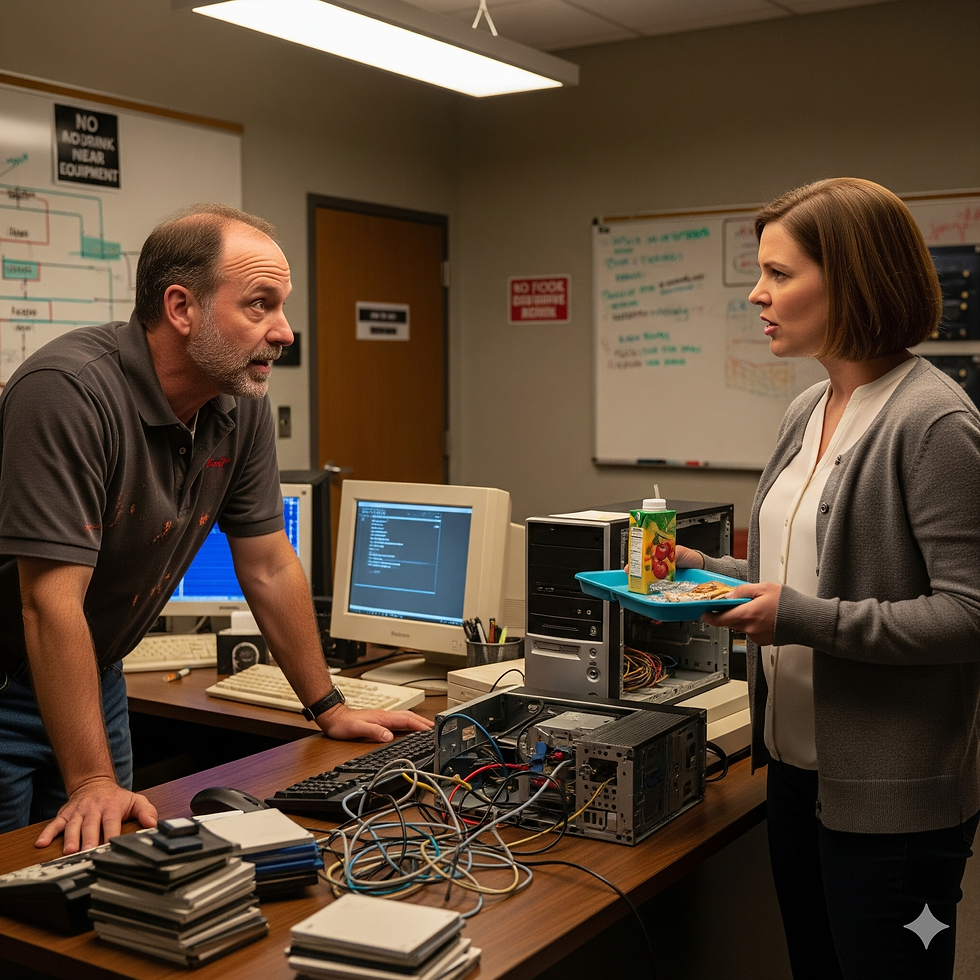Vendors Calls Deemed "Cyber Attacks"
- Ryan Heineman
- Sep 19
- 2 min read
District Tech Department Elevates Vendor Calls to "Red Alert" Cyber Threat Level
SILICON VALLEY WEST, CA—In a move that cybersecurity experts are calling "either genius or completely unhinged," the Unified School District of Silicon Valley West (USDSVW) has officially reclassified unsolicited vendor prospecting calls as a Tier 1, "Red Alert" cyber security threat. The district's tech department, led by the unflappable Dr. Debra Thorne, has deployed an elaborate defense system designed to thwart these "telephonic intrusions" with the same rigor applied to ransomware attacks and phishing scams.
"For too long, our digital perimeters have been secure, but our auditory channels remained vulnerable," Dr. Thorne explained, tapping a complex flowchart on a glowing display in the district's newly fortified "Digital Operations Center." The flowchart meticulously detailed threat vectors, including "unsolicited cloud solution pitches," "unwarranted educational software demos," and the particularly insidious "cold call about interactive whiteboards."
The new protocol, dubbed "Operation Silent Fortress," involves a multi-layered defense. Incoming calls from unrecognized numbers are immediately flagged by an AI-powered voice recognition system, cross-referenced with a database of known vendor sales representatives, and then routed through a series of increasingly elaborate "honeypot" voicemails.
"Our Level 1 defense is a voicemail loop of a kazoo band playing 'The Final Countdown'," detailed Head of Network Security, Brenda "The Blocker" Davis, a veteran IT specialist with a reputation for mercilessly shredding junk mail. "If they persist, they hit Level 2: a 30-minute recording of dial-up internet screeching. Only the truly dedicated—or truly desperate—make it past that."
For vendors who somehow breach these initial defenses and manage to speak to a human, the tech department has trained its staff in "social engineering counter-tactics." These include feigning extreme confusion about basic tech terms, pretending to speak only in binary code, and deploying the ultimate deterrent: asking for detailed pricing on a product that doesn't exist.
One particularly persistent vendor, Mr. Chadington, a regional sales manager for "InnovateEd Solutions," described his recent attempt to connect with USDSVW. "I just wanted to offer them a free trial of our new AI-powered learning platform," he stammered, still visibly shaken. "I got through the kazoo band, then the dial-up, and finally, I thought I had a human! But then she kept asking me for the 'quantum entanglement specs' of our server rack. I… I just hung up. It felt like I was being hacked."
Dr. Thorne, however, remains somewhat apologetic. "These aren't just calls; some are people with really good offerings," she stated, adjusting her headset. "But every minute spent listening to a sales pitch is a minute not spent s rebooting a teacher's ancient laptop. Now that I think about it, maybe I need a quote..."
Regardless, the district has even installed a large, flashing "THREAT DETECTED" warning sign on a screen in its server room, complete with a live feed of the offending vendor's LinkedIn profile, whenever a sales call is successfully blocked. "It's a morale booster," Davis grinned. "Nothing beats the satisfaction of watching a vendor's 'Threat Level' drop back to 'Harmless Spam' in real-time."







Comments